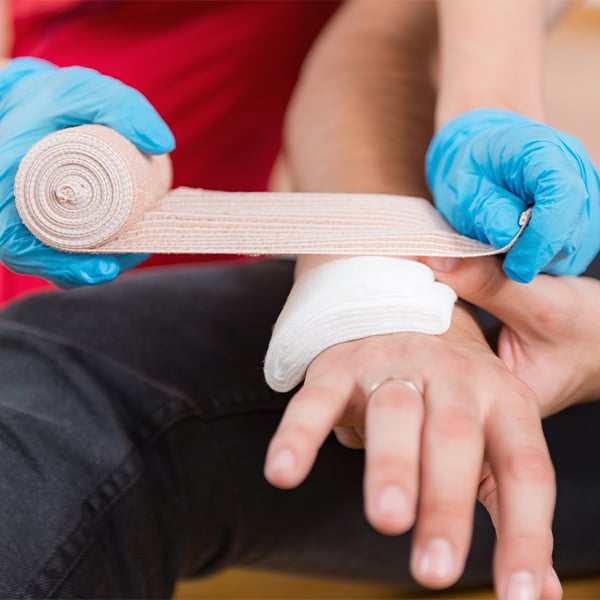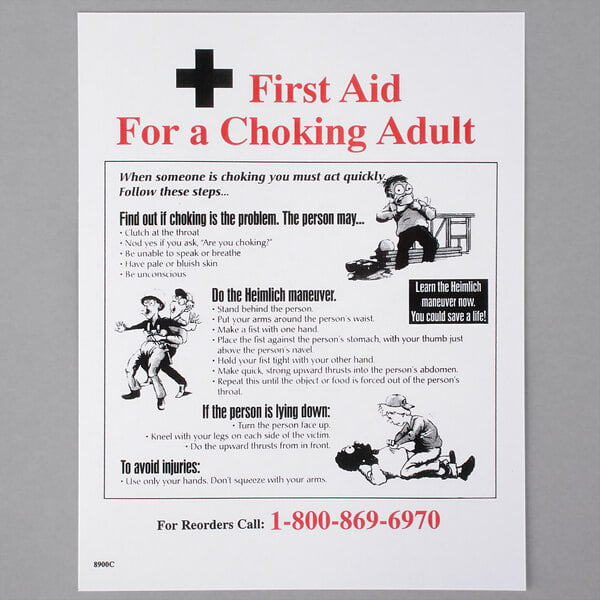Stock the following first aid supplies in your first aid kit.
Hand Sanitizer
Keep hand sanitizer in your first aid kit to sanitize your hands before treating injuries. It prevents germs from contaminating open wounds.
- Minimum Quantity for Class A First Aid Kits: 6
- Minimum Quantity for Class B First Aid Kits: 10
- Minimum Size or Volume: 1/32 oz.
Nitrile Gloves
Nitrile gloves are one of the most important and underrated aspects for conducting first aid. They provide body substance isolation to protect the rescuer from contracting blood-borne pathogens from the patient.
- Minimum Quantity for Class A First Aid Kits: 2 pairs
- Minimum Quantity for Class B First Aid Kits: 4 pairs
- Minimum Size or Volume: N/A
Scissors
Scissors, or trauma shears, play several roles in first aid. While they're primarily used to cut bandages to the proper size and shape, they also aid in removing clothing from severely injured patients during treatment.
- Minimum Quantity for Class A First Aid Kits: 1
- Minimum Quantity for Class B First Aid Kits: 1
- Minimum Size or Volume: N/A
Tourniquet
The term "stop the bleed" is a running mantra in first aid, and a tourniquet is a crucial tool in that initiative. Designed for life-threatening bleeds, it compresses veins and arteries to cut off blood supply to the wound so your patient does not bleed out.
- Minimum Quantity for Class A First Aid Kits: 0
- Minimum Quantity for Class B First Aid Kits: 1
- Minimum Size or Volume: 1" wide
Antiseptic
Antiseptic is a staple of any first aid kit used for treating all types of wounds. It destroys microorganism growth, cleansing wounds before applying a bandage.
- Minimum Quantity for Class A First Aid Kits: 10
- Minimum Quantity for Class B First Aid Kits: 50
- Minimum Size or Volume: 1/57 fl. oz.
Splint
Splints stabilize and protect broken bones until a professional examines the injury. Do not attempt to set a broken bone unless you receive the appropriate training.
- Minimum Quantity for Class A First Aid Kits: 0
- Minimum Quantity for Class B First Aid Kits: 1
- Minimum Size or Volume: 4 1/2" x 24"
Antibiotic Ointment
Open wounds are often dirty, especially when they occur outdoors. Antibiotic ointment prevents infections in minor cuts, scrapes, or burns and cleanses wounds before applying the bandage.
- Minimum Quantity for Class A First Aid Kits: 10
- Minimum Quantity for Class B First Aid Kits: 25
- Minimum Size or Volume: 1/57 fl. oz.
Burn Treatment
Burns are common in commercial kitchens full of hot equipment and busy staff members. Burn treatment reduces the symptoms of the injury, including the associated pain.
- Minimum Quantity for Class A First Aid Kits: 10
- Minimum Quantity for Class B First Aid Kits: 25
- Minimum Size or Volume: 1/32 oz.
Adhesive Tape
Adhesive tape is a must-have for first aid kits. Used for securing bandages to the skin, it's always wise to keep more than the minimum quantity to ensure you have enough for any occasion.
- Minimum Quantity for Class A First Aid Kits: 1
- Minimum Quantity for Class B First Aid Kits: 2
- Minimum Size or Volume: 7 1/2'
Cold Pack
The primary treatment for swelling is the RICE method: rest, ice, compress, and elevate. A cold pack allows you to handle bruises, sprains, and other swollen areas.
- Minimum Quantity for Class A First Aid Kits: 1
- Minimum Quantity for Class B First Aid Kits: 2
- Minimum Size or Volume: 4" x 5"
Triangular Bandage
Commonly used in wilderness medicine, triangular bandages are ideal for slinging and swathing damaged limbs and wrapping around wounds to make a large pressure bandage. You can also cut up clean sheets as an alternative in a pinch.
- Minimum Quantity for Class A First Aid Kits: 1
- Minimum Quantity for Class B First Aid Kits: 2
- Minimum Size or Volume: 40" x 40" x 56"
Trauma Pad
A trauma pad is extremely absorbent and used for treating large wounds. When applying pressure, add a second trauma pad or bandage on top of the injury rather than replacing it.
- Minimum Quantity for Class A First Aid Kits: 2
- Minimum Quantity for Class B First Aid Kits: 4
- Minimum Size or Volume: 5" x 9"
Adhesive Bandages
Adhesive bandages are handy for covering open wounds and controlling bleeding. These bandages conveniently stick to the skin, eliminating the need for additional materials to hold them in place.
- Minimum Quantity for Class A First Aid Kits: 16
- Minimum Quantity for Class B First Aid Kits: 50
- Minimum Size or Volume: 1" x 3"
Breathing Barrier
A breathing barrier is crucial for performing rescue breathing in CPR safely, protecting the patient and rescuer from germs or foreign bodily fluids. Simple breathing barriers are plastic coverings with a valve, but more extensive first aid kits might have a full mask.
- Minimum Quantity for Class A First Aid Kits: 1
- Minimum Quantity for Class B First Aid Kits: 1
- Minimum Size or Volume: N/A
First Aid Guide
While emergency training is crucial, actions during a real crisis are unpredictable. A first aid guide outlines treatments, such as applying a tourniquet, in simple terms so staff members perform them correctly.
- Minimum Quantity for Class A First Aid Kits: 1
- Minimum Quantity for Class B First Aid Kits: 1
- Minimum Size or Volume: N/A
Sterile Pad
Contained in sealed packages until use, sterile pads control bleeding and absorb bodily fluids from wounds. They also cover antibiotic and antiseptic applications on wounds.
- Minimum Quantity for Class A First Aid Kits: 2
- Minimum Quantity for Class B First Aid Kits: 4
- Minimum Size or Volume: 3" x 3"
Gel Soaked Burn Dressing
Use a gel-soaked burn dressing as part of your burn treatment. These bandages help cool and cleanse burns while also protecting them from germs.
- Minimum Quantity for Class A First Aid Kits: 1
- Minimum Quantity for Class B First Aid Kits: 2
- Minimum Size or Volume: 4" x 4"
Eye Covering
Your eyes are vulnerable to flying irritants ranging from fluids to errant nails or splinters. Use an eye covering to protect an injured eye until proper treatment.
- Minimum Quantity for Class A First Aid Kits: 2
- Minimum Quantity for Class B First Aid Kits: 2
- Minimum Size or Volume: 2.9 square inches
Eye Wash
If a foreign object or subject gets into the eye, use eye wash to rinse the contaminants from the affected area. These irritants include chemicals, physical contaminants, or liquids.
- Minimum Quantity for Class A First Aid Kits: 1 fl. oz. total
- Minimum Quantity for Class B First Aid Kits: 4 fl. oz. total
- Minimum Size or Volume: N/A
2" Rolled Bandage
Once you apply a bandage or trauma pad to a bleeding wound, use a rolled bandage to secure the dressing and continue applying pressure. A 2" rolled bandage is ideal for small areas such as an arm or foot.
- Minimum Quantity for Class A First Aid Kits: 1
- Minimum Quantity for Class B First Aid Kits: 2
- Minimum Size or Volume: 2" x 12'
4" Rolled Bandage
A 4" rolled bandage is crucial for creating pressure bandages to treat severe wounds. Wrap it around the dressing to hold it in place, or use it to secure a splint or sling.
- Minimum Quantity for Class A First Aid Kits: N/A
- Minimum Quantity for Class B First Aid Kits: 1
- Minimum Size or Volume: 4" x 12'
Additional Supplies
While these additional first aid supplies are not officially required, they help rescuers gather information and provide necessary treatment for injuries. If reusable items are utilized during treatment, thoroughly clean and sterilize them before replacing them in the kit.











